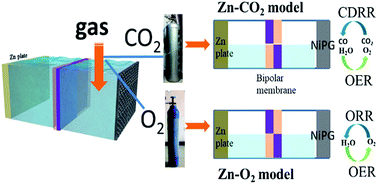A trifunctional Ni–N/P–O-codoped graphene electrocatalyst enables dual-model rechargeable Zn–CO2/Zn–O2 batteries†
Abstract
Sustainable energy and environmental developments require exploring multi-functional energy conversion and storage, such as metal–air batteries, water splitting and CO2 electro-reduction, which is bottlenecked by the lack of multi-functional electrocatalysts. Herein, we designed and synthesized a Ni–N and P–O codoped graphene (NiPG) nanomaterial for trifunctionally electrocatalyzing the oxygen evolution reaction (OER), oxygen reduction reaction (ORR), and carbon dioxide reduction reaction (CDRR). Beyond the known role of P–O and Ni–N units for the OER/ORR and CDRR, separately, the P–O unit, which expressed high activity in the HER, was found to suppress the competitive HER towards enhanced CDRR on NiPG over Ni–N doped graphene, firstly. Besides, the Ni–N unit also promoted the OER/ORR over P–O doped graphene. Based on this trifunctional NiPG electrocatalyst, we realized dual-model Zn–CO2/Zn–O2 batteries, switched by supplying CO2 or O2. This work provides the novel design of multifunctional electrocatalysts and dual-model batteries for the versatile application demands of energy conversion and storage.



 Please wait while we load your content...
Please wait while we load your content...